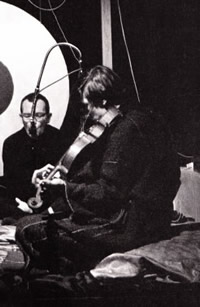

New York 1964-12-12
The Tortoise Recalling The Drone of The Holy Numbers as They Were Revealed in The Dreams of The Whirlwind and The Obsidian and Illuminated by The Sawmill, The Green Sawtooth Ocelot and The High-Tension Line Stepdown Transformer at the Pocket Theatre in New York - December 12, 1964.
From the notes of La Monte Young:
The specific rules that governed the performance of my music, including the sections of The Tortoise, His Dreams and Journeys participated in by Tony Conrad and John Cale, create a sound characterized by the predominance of musical intervals whose numerators and denominators in just intonation are factorable by the primes 7, 3, and 2, and selected higher primes, especially 31, and by the exclusion of intervals whose numerators and denominators are factorable by the prime 5. If we represent intervals with numerators and denominators factorable by the primes 7, 3, and 2 in conventional music notation and terminology, we obtain intervals that include various sized major and minor sevenths (with emphasis on the septimally derived blues minor seventh in my compositions such as Bb Dorian Blues, Early Tuesday Morning Blues, Sunday Morning Blues, and The Tortoise), perfect fifths, octaves, unisons and their inversions, various sized major and minor seconds, and perfect fourths. The blues I was playing on the sopranino saxophone, directly preceding the period of The Tortoise, emphasized a technique I invented consisting of extremely fast combinationpermutations of a limited set of tones to simulate a sustained chord. And the chord I increasingly emphasized consisted of the pitches Eb, Bb, Db, Eb, (the IV-chord from Bb Dorian Blues) extended over the full range of the saxophone. Translated back into just intonation, these pitches are all examples of octave transpositions of the primes 7, 3, and 2.